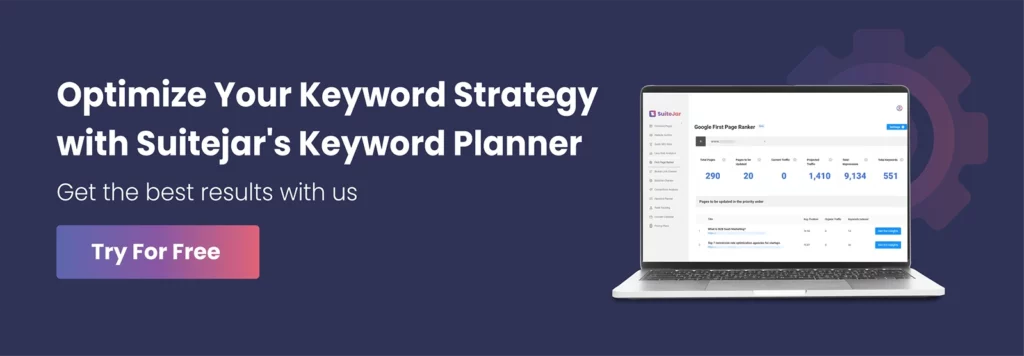Only $99 for a full year!
No credit card required
Rank on Google's first page in 3 months
The Role of AI in Streamlining Keyword Clustering
Feb 14, 2024 | user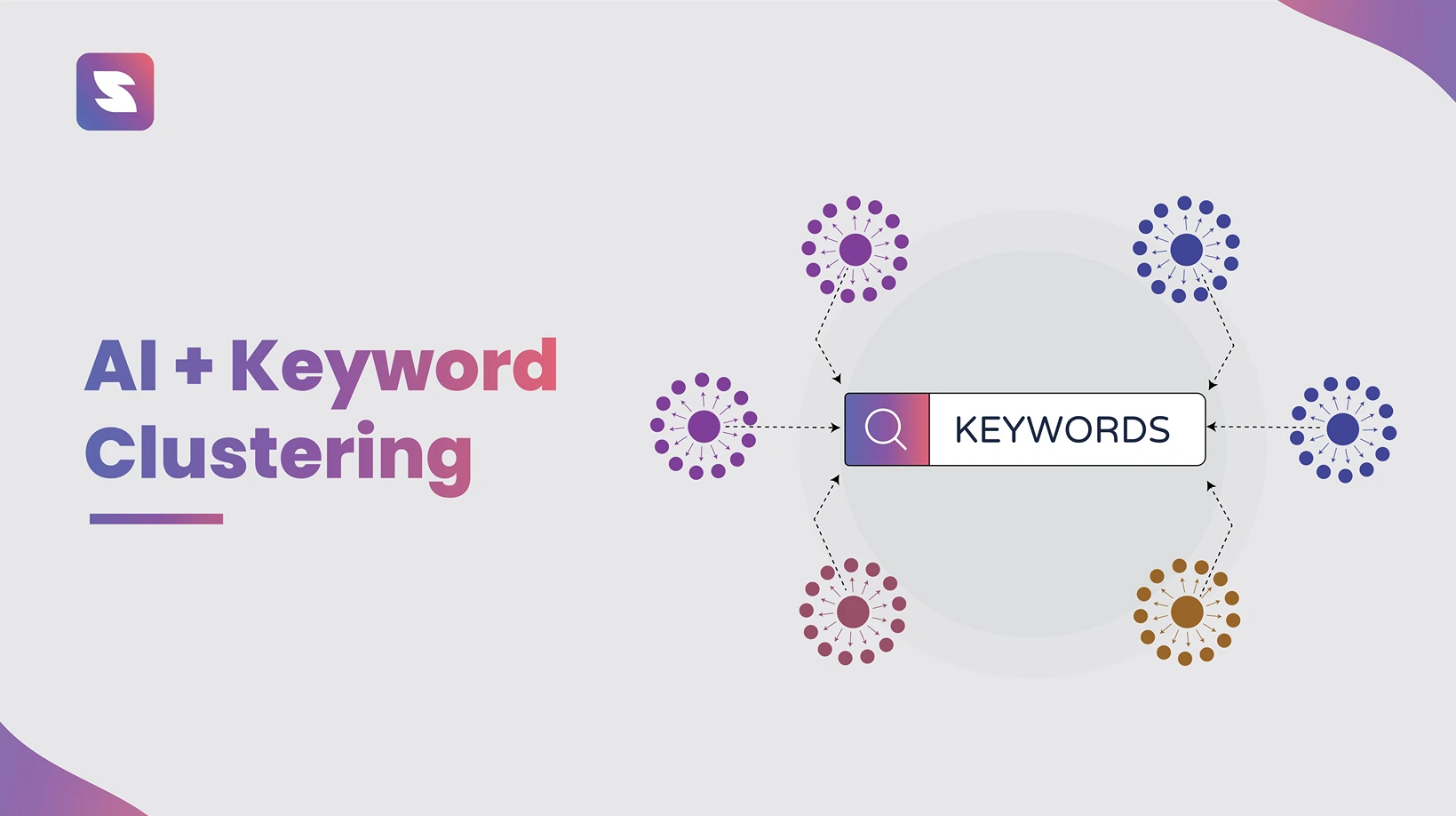
Are you looking to improve your on-page SEO strategies to align with Google’s advanced algorithms?
Keyword Clustering is the answer.
Keyword clustering involved extensive keyword research and a keen intuition to discern patterns and relationships among search terms. Think of it as organizing keywords into groups that share similarities or are related.
It’s about making sure the content resonates more accurately with what users are searching for, enhancing their experience on the web. And the work was very manual, time-consuming, and required much patience and insight.
But the advent of Artificial Intelligence (AI) changed all that. With AI in keyword clustering, you can now analyze large datasets and identify patterns at a scale and speed that exceed human capability.
Here, we will discuss how AI impacts keyword clustering, its benefits, and strategies for performing keyword clustering using an AI tool for keyword research.
The Basics of Keyword Clustering
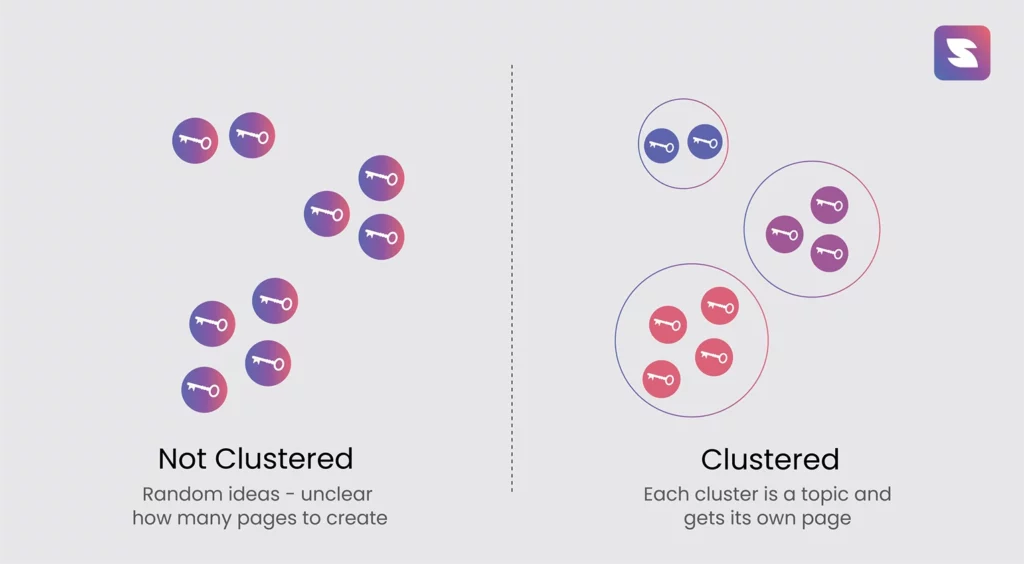
Keyword clustering is a strategic approach used in SEO and content marketing to group similar or related keywords. This method allows for creating content that targets multiple related search queries at once rather than focusing on a single keyword per piece of content.

This enhances the chances of ranking higher in search engine results pages (SERPs). It also enhances user engagement by providing more relevant and comprehensive content.
Traditional Keyword Clustering
Traditionally, keyword clustering involves manually shifting through keyword research data to identify patterns or themes among search terms.
- Marketers would use spreadsheets to categorize keywords based on similarities in user intent, search volume, or topic relevance.
- This method required a significant investment of time and effort, with the accuracy of the clusters heavily reliant on the marketer’s intuition and experience.
How AI Transforms Keyword Clustering
Artificial intelligence transforms keyword clustering by automating the analysis and categorization of the vast datasets of keywords.
- AI can quickly identify patterns and relationships among keywords and speed up the process.
- AI algorithms employed in keyword clustering typically involve natural language processing (NLP) and machine learning.
- NLP allows the AI to understand and interpret human language, identifying the context and intent behind search queries.
- Machine learning, on the other hand, enables the AI to learn from data over time.
Integrating AI into keyword clustering automates the process so marketers can develop more effective content strategies that resonate with search engines and users.
Here is a table where you can easily understand the difference:
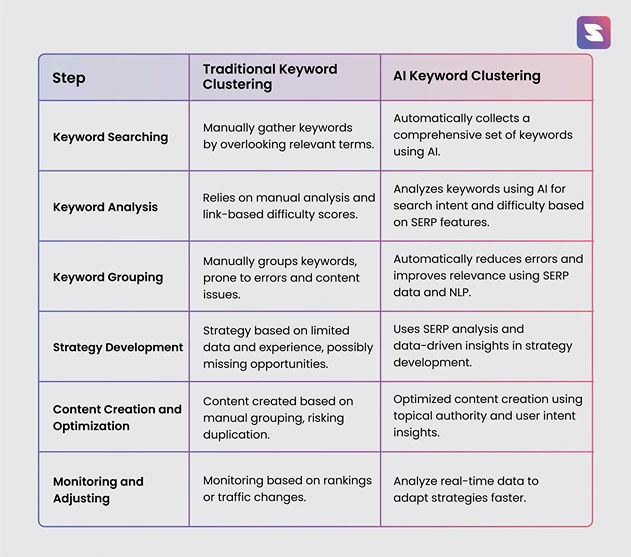
Benefits of Keyword Clustering with AI
AI keyword clustering has come with so many benefits in the way it approaches SEO and content strategy.
Some of the main advantages of AI keyword clustering are:
1. Time savings
One of the essential benefits of AI keyword clustering is its efficiency and time savings. With AI, you can easily do it in a short time. AI algorithms swiftly sift through thousands of keywords, identifying patterns and grouping them with unparalleled speed.
SEO professionals and marketers can allocate their valuable time to more strategic tasks. They can take more time in content creation and optimization than data analysis.
2. Improve Accuracy
AI improves accuracy and relevance in your keyword clustering process. Traditional methods are reliant on manual analysis. That comes with more human error and subjective interpretations.
AI applies consistent criteria to evaluate and cluster keywords, minimizing the risk of errors. This leads to keyword groups that are accurate and relevant to the user’s search intent.
It helps improve their rankings by ensuring content aligns with these keyword clusters. That helps in drawing a more targeted audience.
3. User Intent and Search Behavior
AI keyword clustering is the ability to understand user intent and search behavior. AI algorithms can interpret search queries in a way that mirrors human understanding.
This allows for a more refined analysis of search patterns and insights into user needs. Marketers can tailor their content strategies to meet users’ needs more effectively. Also, it fosters a better user experience and encourages engagement.
Implementing AI in Your Keyword Strategy
Step 1: Choose the Right AI Keyword Clustering Tool
The first step is selecting the appropriate tool that aligns with your objectives.
Look for AI-powered keyword research tools like SuiteJar that offer advanced features such as a complete keyword planner, trend analysis, and the capability to process large datasets efficiently.
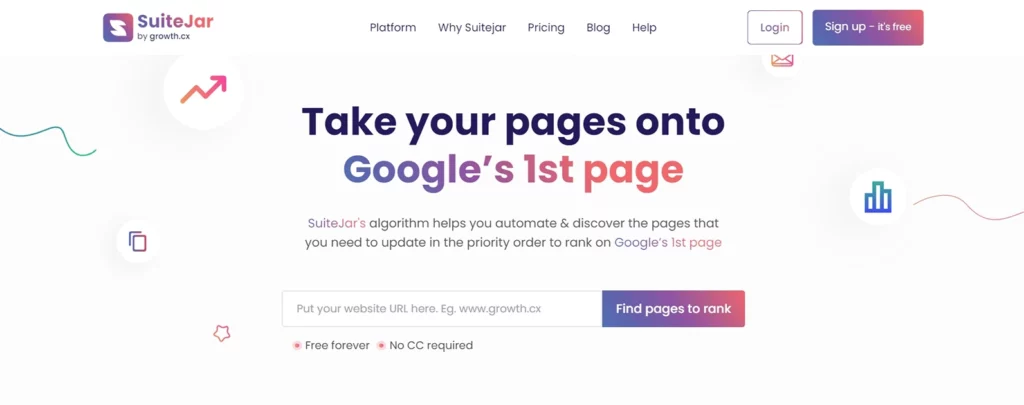
Enter your chosen keyword tailored to your target audience. Keep it short to maximize getting details of related keyword results within the planner.
Next, specify your target country (SuiteJar offers insights for over 100 countries) and click on the ‘search.’

The tool will present closely related variants of your targeted keyword and valuable data on current search volumes, SEO difficulty, paid difficulty, and cost per click.
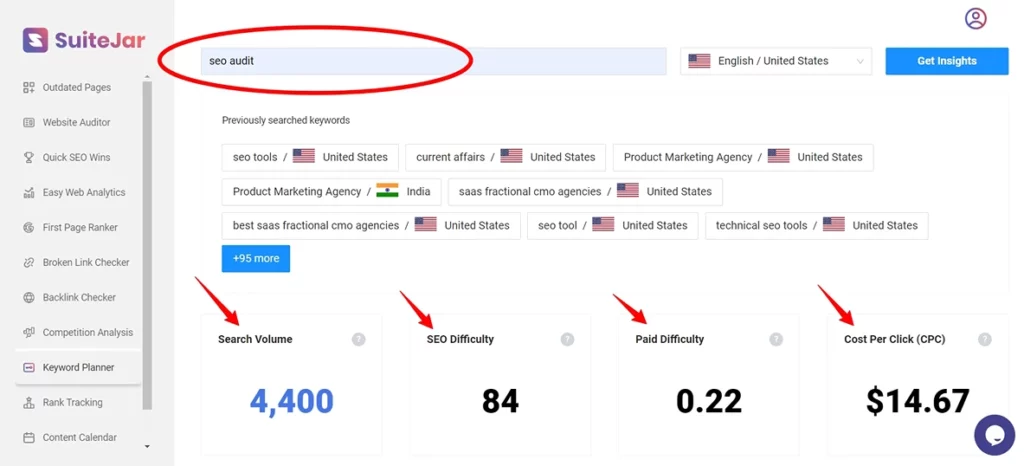
You can get the trends associated with your selected keyword. That includes whether it’s gaining popularity alongside search volume metrics. Also, get related keywords with trend data, volume, search difficulty, paid difficulty, and CPC.
Consider the suggested keyword clusters generated by the tool to help your content. You can optimize your webpage content for search engines and align it with user intent.
Suggested Read: Best Content Analysis Tools in 2024
Step 2: Categorize Your Keywords
- Group by Search Intent
Organize your selected keywords into clusters based on their search intent (informational, navigational, commercial, transactional). Analyze SERPs to understand the purpose behind each keyword.
- Consider SERP Similarity and Content Quality
Ensure that keywords within a cluster share SERP similarities and can be addressed with quality content. This involves combining or separating keywords based on the potential for creating better content.
Step 3: Plan Your Keyword Strategy
- Select Primary and Secondary Keywords
Identify a primary keyword within each cluster with a high search volume. This keyword should anchor your content.
The remaining keywords become secondary, supporting the primary keyword and covering additional nuances of the topic.
- Content Planning
Determine whether you can optimize old content or need to create new content to target the keywords in each cluster effectively.
Step 4: Optimize or Create Your Content
- Incorporate Keywords
You can add your primary keyword in the URL, title tag, meta description, and H1 tag. Use primary and secondary keywords naturally throughout the content, in subheadings, and links to related pages.
- Focus on SEO Practices
Ensure your content follows SEO best practices, such as maintaining readability and using appropriate text length.
Step 5: Track Your Keyword Rankings
- Monitor Performance
Use a tool like SuiteJar or Ahref to track how well your pages rank for the targeted keywords in your clusters. This will help you track the success of your keyword clustering strategy.
- Adjust as Necessary
Make necessary adjustments to your strategy based on your tracking. This could involve further content optimization, revisiting your keyword clusters, or refining your target keywords based on performance.
Following these steps ensures that your content is optimized for a broad range of relevant keywords and can attract more organic traffic to your website.
Also Read: Best Content Marketing Tools in 2024
Future of Keyword Research Tips 2024
- Prioritize understanding the intention behind the user’s query and provide them with appropriate and helpful information.
- Optimize voice search and conversational queries to improve visibility in voice search results.
- AI-powered tools for predictive analysis of search behavior and emerging trends.
- Mobile optimization of keywords and content for better performance on smartphones.
- Local-specific keywords to leverage platforms like Google My Business (GMB) for local search visibility.
- Visual and video search optimization integration using descriptive, keyword-rich titles and tags.
- Semantic search optimization focuses on topics and concepts rather than just keywords.
- User-generated content and social media signals for keyword research and content creation.
Conclusion
Keyword clustering is essential to SEO strategy and requires practical tools and techniques.
It’s essential to remember the significance of AI in keyword clustering and utilize the best tools available to achieve optimal results.
Consider using SuiteJar, an advanced SEO AI tool that utilizes ChatGPT-4 for generating topics and clustering keywords. With this tool, you can quickly analyze trends and identify keyword clusters.
